Would you believe I actually got to engage in a little bit of recoil therapy this weekend? Thanks to KR Training for letting us use their range after the class, and thanks to Greg Ellifritz for putting on a great class: “The Explosive Threat: Recognizing, Detecting, and Neutralizing the Terrorist Bomber”.
I didn’t do a lot of shooting because it was hotter than the hinges of Hell, and we didn’t have a lot of time before our dinner engagement. But I did manage to function check a couple of carry guns, and am reasonably satisfied with their performance.
I finished Ammunition, Demystified: The (non) Bubba’s Guide to How Ammo Really Works on my trip. My opinion hasn’t changed. I absolutely do recommend it. But you should be aware that there’s some pretty heavy duty math in the book. I think most folks could probably benefit from it even if times tables give them a headache. My only other issue with the book came when Mr. Siewert discussed some ballistic work he did back in the day with a company that was making air rifle pellets. My issue? “Where were you when I was a teenager, Mr. Siewert?”
And now for some more gun books from the stack…
Big Game Hunting & Marksmanship, A Manual on the Rifles, Marksmanship & Methods Best Adapted to the Hunting of the Big Game of the Eastern United States, Kenneth Fuller Lee. Small-Arms Technical Publishing Company, Marines, Onslow County, North Carolina, 1941. Riling 2364.
This has a January 1941 ad page date, and the advertised books inside, on the jacket flaps, and on the rear cover are all consistent with that date. The cover also has the Onslow County imprint matching the title page. This is probably a second printing: Smith lists the second printing as having a 1941 title page date and ad page date, and doesn’t mention a title page date on the first.
I think this is a nice copy, perhaps tending in the direction of “good” but maybe not “very good”. There are some small chips missing at the top and bottom of the front and rear jacket (more noticeable on the rear jacket) and a large chip out of the top of the spine. I don’t think there’s much fading to the spine, but I haven’t seen a pristine copy to compare it to.
Smith says this was only moderately successful, as Lee was not that well known. Smith also doesn’t provide a whole lot of background on Mr. Lee, though he does mention that Lee and Mr. Samworth knew each other (Lee having contributed to the American Rifleman while Samworth was editing it).
$56 including shipping from Appledore Books on ABE. I’m satisfied.
Cartridges of the World, 17th Edition: The Essential Guide to Cartridges for Shooters and Reloaders, W. Todd Woodard and Frank C. Barnes. Readily available on Amazon, so not going to say very much here.
A while back, someone posted a list of five essential gun reference books (in their opinion). This was one of them, I came into some Amazon funny money, and ordered a copy. I think it is a good reference to have, but I do have at least one minor quibble so far: it doesn’t have any data for the .270 Gibbs cartridge.
(This is slightly an inside joke. Mike the Musicologist and I are both interested in picking up Ruger No. 1 rifles. I’m looking for .22 Hornet or .45-70 chamberings. My local gun shop has a No. 1 with a scope for $1200. Which probably isn’t bad, but it is actually chambered in .270 Gibbs. The only load data I’ve found for that cartridge is on LoadData.com and requires a subscription. It isn’t listed in any reloading manuals. You can’t even get cases for it: the one company that we found that was making cases went out of business. I think you can fireform them from other brass, but I’m not sure what the process is. Mr. Gibbs, it seems, was an interesting person: kind of like P.O. Ackley in the wildcat cartridge department, but much more secretive. “He kept his test records secret, evidently instructing his wife to burn them just before his death from leukemia, at age 58, in 1973.“)
Hobby Gunsmithing, Ralph T. Walker and Jack Lewis (ed.). Digest Books, 1972.
FotB RoadRich was at Half-Price Books, found this, and texted me asking if I wanted it. I said, “Sure!” I disremember how much I paid him, but it wasn’t much more than the cover price.
As bad as I am with tools, I am interested in gunsmithing, and this seems like a handy reference to have around (along with the various Samworth gunsmithing books, and the project guides Guns magazine publishes).
Makers of History, F. Romer. Colt’s Patent Fire Arms Manufacturing Co., 1926.
This is a neat little bit of ephemera that I picked up at the Texas Gun Collector’s Association show in April, and don’t know a whole lot about. It was $10, I had $10 cash on me, so I took a flyer.
It is basically a collection of “action stories”, for want of a better word, about Colts. Almost entirely black powder revolvers, and many of them Single Action Army revolvers. The writing seems kind of pulpy to me, like a book of Canadian Mountie stories FotB Dave loaned me a while back. I suspect, but can’t prove, that “F. Romer” (if that isn’t a pen name) had some experience writing for the pulps.
I don’t know if this was a giveaway, if you saved up your box tops and sent off for it, or what. I feel like I can say this is at least a second state. There’s no printer’s key, but it does have the slip referenced in ABE entries laid in. (That’s an errata slip, explaining that Captain George D. Wallace was killed by Indians, instead of committing suicide to avoid capture.)
$10 is probably a little above market, but not too much, and I liked the seller. I even had dinner with him and some other folks later on. And I thought it would be an interesting little book to blog that wasn’t about Smith and Wessons.
Next time: There are even more Samworths in the stack? Plus: old gun sights are exciting!
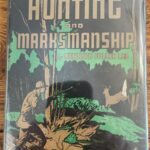
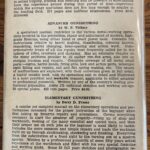
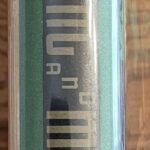
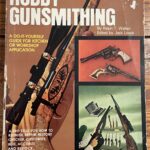
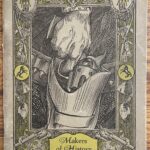
Hobby Gunsmithing: A Do-it-yourself Guide for Kitchen or Workshop Application had been originally sold for $5.95 (printed on the cover as “Five Dollars and Ninety-Five Cents”), but the used price was just under $5.